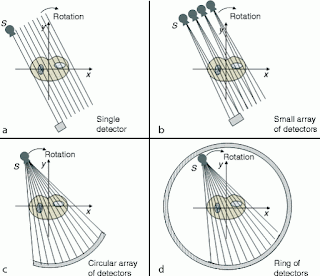What is CT Scan ?
Computed tomography is more commonly known as ‘CT’. It was also
known as ‘CAT’ which stands for Computed Axial Tomography.
CT is a way of using X-rays to take detailed pictures or images in
very fine slices through the part of the body that the doctor has asked to be
investigated - similar to looking at one slice of bread within the whole
loaf.
Tomography is actually originated from the Greek words which are
‘tomos’ means slice, and the Greek word ‘graphein’ means write.
These multiple slices of images which are two-dimensional (2D) X-ray images that are generated during a CT scan can be reformatted in multiple planes, and reconstructed into three‐dimensional (3D) images - in other words, many pictures of the same area are taken from many angles and then placed together to produce a 3D image.
These multiple slices of images which are two-dimensional (2D) X-ray images that are generated during a CT scan can be reformatted in multiple planes, and reconstructed into three‐dimensional (3D) images - in other words, many pictures of the same area are taken from many angles and then placed together to produce a 3D image.
2D images of CT Scan of heart
3D images for CT Scan of heart
When CT scanners were first invented, they took one slice at a
time and were quite slow when compared to today’s machines. Most modern
scanners now take more than one slice at a time.
This may range from 4 to 64 slices and up to 320 slices for the
most recent machines. This is referred to as “multislice” or “multidetector”
technology and may be abbreviated as MSCT or MDCT.
What CT Scan is used for?
CT images of internal organs, bones, soft tissue and blood vessels
typically provide greater detail than traditional x‐rays, particularly of soft tissues and
blood vessels.
Using specialized equipment and expertise to create and interpret
CT scans of the body, radiologists can more easily diagnose problems such as
cancer, cardiovascular disease, infectious disease, appendicitis, trauma and
musculoskeletal disorders.
CT can be a life-saving tool for diagnosing illness and
injury in both children and adults.
It is also often used to look inside the body before another
procedure takes place, such as radiotherapy treatment or a biopsy (where a
small sample of tissue is taken so that it can be examined under a
microscope).
How does it work?
CT Scanner produces more detailed image rather than X-ray machine
as CT Scanner emits a series of narrow beam compare to diagnostic X-ray machine
only emit one way radiation beam.
The X-rays from the CT Scanner will be received by a detector that
is located on the opposite side of your body which can see hundreds of
different levels of density and also tissues inside a solid organ.
Then, images of the scan will be produced by a computer and can be
viewed on a computer monitor, printed on film or transferred to a CD or DVD.
Sometimes a contrast dye is used because it shows up much more
clearly on the screen.
If a 3D image of the abdomen is required the patient may have to
drink a barium meal. The barium appears white on the scan as it travels through
the digestive system. If images lower down the body are required, such as the
rectum, the patient may be given a barium enema. If blood vessel images are the
target, the barium will be injected.
Bottles of barium that patients
need to drink before undergoes CT procedure
Who does Computed Tomography?
Radiographers or radiation technologists will perform the CT Scan procedure for the patient. The CT scans are interpreted by radiologists who will examine the images taken by the radiographers in great detail to know any pathological conditions of the patient.
Videos
About how CT Scan works
About CT Scan procedure











